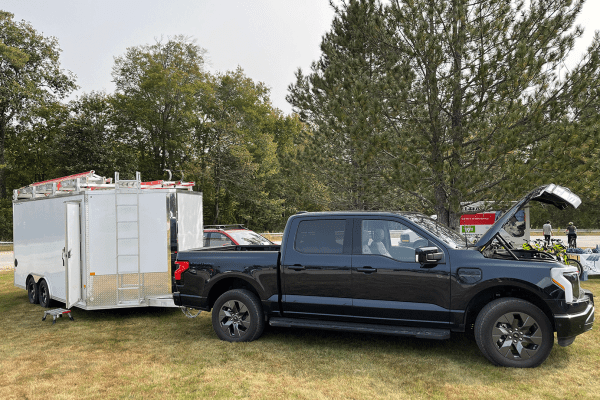When drivers purchase an electric car or truck they may not realize that they’re also getting a potent energy storage device out of the deal as well. Electric vehicle (EV) batteries won’t just help get us around, they are a potentially powerful and promising tool for building a more resilient and affordable clean energy grid that keeps costs as low as possible for utility customers in Maine. Here’s how.
EV batteries have a huge amount of storage capacity — often the equivalent of several days of electricity use for an average home. As demand for EVs continues to grow and we see more and more EVs on the road, vehicle charging may strain the grid without proactive planning. But with proper management, they can be a net boon to ratepayers – bringing down rates across the board and providing flexibility to help avoid costly transmission and distribution infrastructure upgrades. On the personal consumer front, EV batteries can also provide significant individual benefits to Maine people in their homes.
The first way to achieve these gains is through smart charging. Traditionally, the highest demand hours on the grid are in the evenings, as people across the state get home and start to turn on appliances for cooking, heating, lighting, cleaning, and entertainment. As EVs grow in popularity, having hundreds of thousands of EVs charging during those peak hours could strain the grid. However, most EVs are plugged in for a longer period through the night when demand across the grid is relatively low. By scheduling charging for this low-demand or off-peak time, through technology and well-structured time-of-use rates that offer lower power prices when demand is generally lower, EVs can help flatten out peaks in demand on the grid and take advantage of increasingly abundant low-cost home-grown clean energy sources like wind and solar.
Residential customers in Maine can already realize smart charging savings by enrolling certain brands of EV chargers and EVs to receive a financial incentive through Efficiency Maine Trust’s initiative to avoid charging on days and times when the system is maxed out, usually on a handful of hot summer days, automatically delaying charging until later in the evening.

Ford Lightning electric truck (JCaldwell/NRCM)
The second way – especially poignant after this past season of extreme weather events — is by providing backup power to support Maine households during power outages. Essentially, your EV battery could potentially serve as a backup generator when the lights go out. The average battery for the current generation of EVs can fully power an American household for three days in the instance of a power outage. Here in Maine, that could be a game changer. Maine residents have more power outages annually than those in any other state, with the average duration of power outages coming in second out of 50 states.
We expect that “vehicle-to-home” or V2H technology will become increasingly standard. For example, Ford’s electric F150 Lightning offers this capability, and GM and BMW both recently announced that V2H will be included in all of their electric vehicle models in the next few years.
 Storm damage is becoming increasingly expensive as well. Central Maine Power’s (CMP) storm restoration costs have increased from approximately $55 million in 2017 to more than $190 million in 2023.¹ With climate-linked storms increasing in frequency and intensity, EVs are poised to become a key tool for during and after the extreme storms we’re experiencing more often due to climate change.
Storm damage is becoming increasingly expensive as well. Central Maine Power’s (CMP) storm restoration costs have increased from approximately $55 million in 2017 to more than $190 million in 2023.¹ With climate-linked storms increasing in frequency and intensity, EVs are poised to become a key tool for during and after the extreme storms we’re experiencing more often due to climate change.
EV owners across Maine were already taking advantage of this functionality during last winter’s storms and resultant power outages. For example, Bambi Jones of Whitefield was able to keep her home up and running off the 240-volt, 30-amp outlet on her Ford F-150 Lightning during the power outage caused by the April 3rd storm.
Third, electric vehicle batteries will soon be able to act as a “virtual power plant” in their own right. At moments when grid demand is at its highest, like a winter cold snap, or hot summer day, “vehicle to grid” or V2G technologies will allow grid operators or aggregators to discharge EV batteries, potentially preventing the need to turn on expensive fossil fuel “peaker” plants or avoiding a blackout – saving ratepayer money across the board.
Preliminary analysis done for the Governor’s Energy Office’s “Pathways to 2040” study found that widespread deployment of load management practices that include V2G capabilities could reduce the growth of peak demand by roughly half by 2050, representing billions of dollars in savings in avoided grid spending.

MDI’s electric school bus (AFetcher/NRCM)
Electric school buses at certain school districts around the country have already begun to demonstrate the promise of this approach.
Lastly, switching our overall energy demand away from fossil fuels, and into our electricity system, can actually help lower the cost impact of grid investments by spreading fixed costs across more kilowatt-hours of overall electricity use, one of the key tenets of “beneficial electrification.“
Recent research shows that over the last 11 years, EV drivers across the United States have contributed approximately $3.12 billion more than their associated costs, driving rates down for all customers. When expenditures for EV programs are also included in the analysis, EV owners have still contributed approximately $2.44 billion more in revenues than in costs. A recent study specific to Maine showed that had our state adopted the Advanced Clean Cars II program, bringing more EVs to Maine would have brought $169 million in customer utility savings every year by 2050.
Climate change is the greatest threat to Maine’s communities and natural resources alike. Successfully addressing climate change will require broad changes to how we generate and use energy – transitioning how we power industry, buildings, and transportation toward clean electricity and away from burning fossil fuels. The good news is that we have most of the technologies we need to make this switch. Better still, these technologies often perform better, cost less to operate, and are more efficient than their fossil-fuel counterparts.
Adding hundreds of thousands of heat pumps, zero-emission vehicles, and large amounts of wind, solar, and battery energy storage will require significant investments in our current electric grid, smarter planning practices, and policies that enable a more flexible and participatory grid to maximize the use of our existing infrastructure, avoid and defer new investments, and save ratepayers money.
Much work still needs to be done to realize the potential of these technologies to support a more resilient, flexible, dynamic, and affordable clean energy grid, including progress in electricity and utility regulatory reform, rate design, integrated grid planning, beneficial electrification policies and programs, and more. The Natural Resources Council of Maine will continue to push for progress in this critical area of Maine’s efforts to fight climate change, to both reduce emissions, but also to save drivers and utility customers money as the energy transition proceeds.
—Josh Caldwell, NRCM Climate & Clean Energy Outreach Coordinator
1 Central Maine Power Company, Annual Compliance Filing and Request for Approval of Annual Price Change, Docket No. 2023-00038, Data Response, OPA-011-086_Attachment 1










Leave a Reply